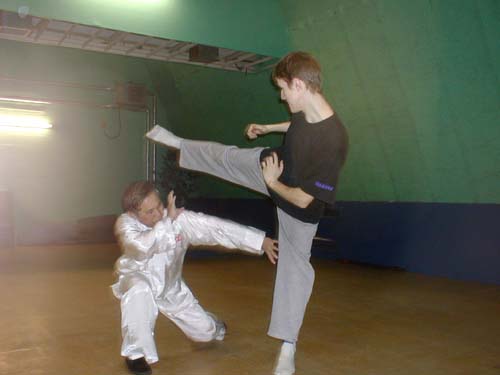SPARRING CAN BE A PLEASANT EXPERIENCE

Sparring can be fun
Question
I have practiced Okinawan Karate since the age of nine. But I have been studying Shaolin Kungfu in hopes of understanding my own techniques better (particularly in application and force training). I have read your book, “The Art of Shaolin Kung Fu”. Needless to say, I was very impressed. I don't have a particular question but I really felt that I should thank you for providing such great information in your books and on your website. I believe that true masters are rare these days. One day, if I find a Shaolin teacher to accept me, I will practice and learn what I believe to be one of the greatest martial arts — one of the “Mother Arts” to all martial arts, including my own.
-- Alex, Canada
Answer
Thank you for your kind words. I am glad you have found my book rewarding.
I have some advice for you and other dedicated martial artists like you. I believe my advice will have much impact not only on your training but also on your life. My advice is not targeted at any particular martial art, but is applicable to all martial arts in general.
Ask yourself what you actually want from your training. Most martial artists would say that they want to defend themselves and to be healthy. Amazingly, despite practicing devotedly for many years, most of them fail to achieve their aims, and, worse, are not even aware of this failure.
Typically, martial artists punch and kick one another in their sparring. Those whose typical training does not include sparring, as in modern wushu and many kungfu schools which teach only solo sets, often mimic free sparring in karate and kickboxing. They think that they will learn self defence this way.
This is a big mistake. They only learn to punch and kick their classmates, but they never learn self defence. If they can defend themselves efficiently, they would not be routinely punched and kicked. They would not regard being punched and kicked as an expected occurrence in martial art training. It is precisely the reverse. One learns a martial art so that he would not be punched and kicked.
Sustaining such internal injuries regularly certainly is bad for health. The harm is insidious. The martial artists may not be clinically sick, like diagnosed with diabetes or tuberculosis, but the internal injuries will affect the working of their organs and systems, and consequently affect their daily performance as well as their life span. It is a big irony for them to think that they practice martial arts for health.
I hope you may not have such problems. But if what I have described relates to your situation, you should find solutions to your problems. You should re-examine the philosophy and methodology of your practice. Take comfort that doing so is not a betrayal to the art you are practicing.
In fact you are contributing to it, and to the welfare of your students or classmates. If you are an instructor yourself you can gradually make appropriate changes. If you are a student, you can politely discuss it with your instructor, and he will appreciate it. You may, for example, work out ways whereby you all can spar using the techniques of your art but without hurting one another unnecessarily.
From your e-mail you strike me as a respectful, dedicated martial artist — the type that any master will find it a joy to teach. Perhaps you may like to attend my Intensive Shaolin Kungfu Course. Even if you have not learnt Shaolin Kungfu before, your many years of experience in Karate can provide you the prior experience necessary for my course requirement. We have a comprehensive sparring methodology, where our students not only do not hurt one another in sparring but actually find it both a pleasant and educational experience.
If you like, you can share some of our Shaolin Wahnam sparring methods with your Karate students or classmates. Of course they will be unable to spar as well as you do in the course, but at least you can open them to the possibilities that sparring need not be hurting one another.
Actually such sparring methodologies were found in Karate and other martial arts, otherwise the samurais of old would have killed one another in their own training even before they met their enemies. But, as in the case of kungfu, these sparring methodologies are now generally lost. We in Shaolin Wahnam are very lucky to have preserved these sparring methodologies.
LINKS
